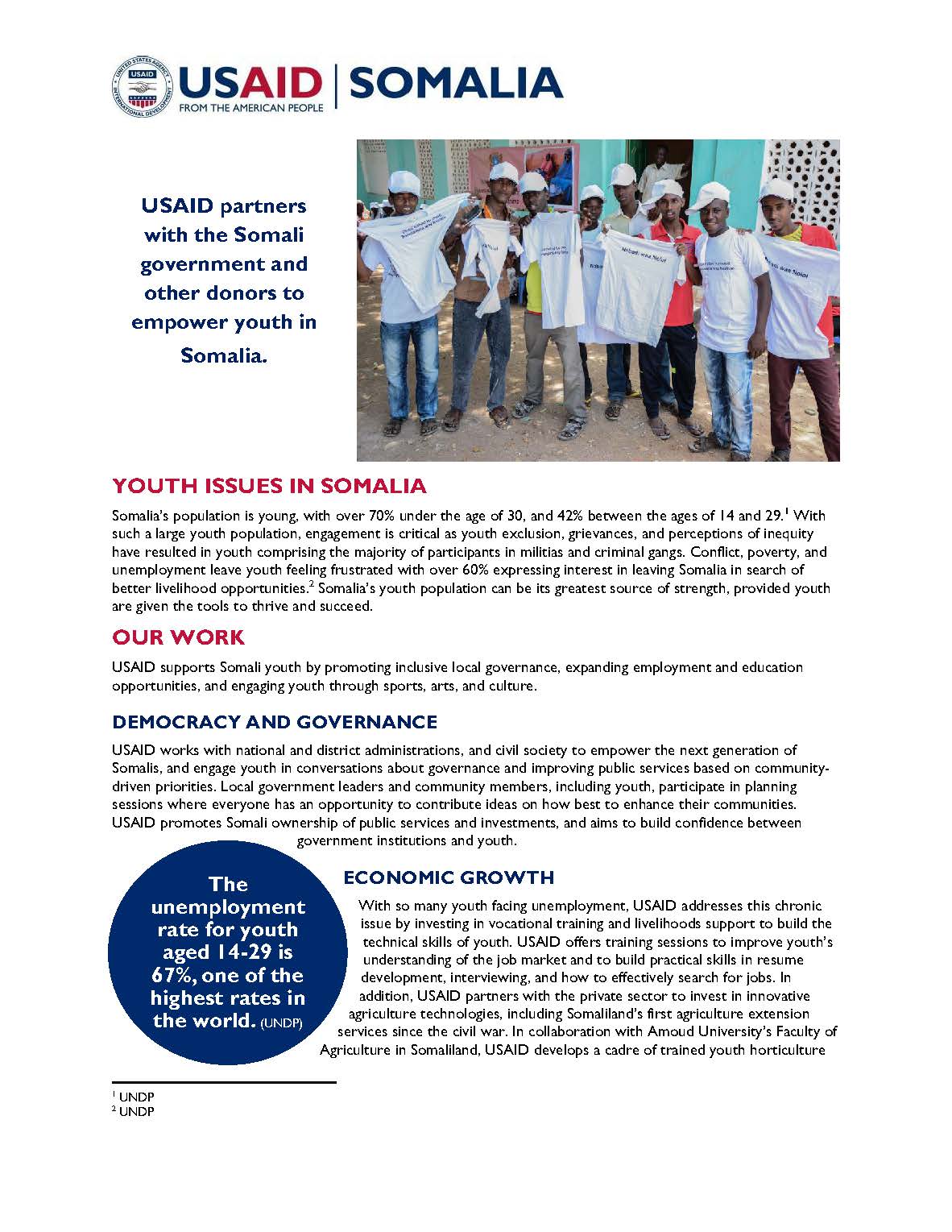Home » Somalia Cross-Cutting Fact Sheet - Youth
USAID partners with the Somali government and other donors to empower youth in Somalia.
YOUTH ISSUES IN SOMALIA
Somalia’s population is young, with over 70% under the age of 30, and 42% between the ages of 14 and 29.1 With such a large youth population, engagement is critical as youth exclusion, grievances, and perceptions of inequity have resulted in youth comprising the majority of participants in militias and criminal gangs. Conflict, poverty, and unemployment leave youth feeling frustrated with over 60% expressing interest in leaving Somalia in search of better livelihood opportunities.2 Somalia’s youth population can be its greatest source of strength, provided youth are given the tools to thrive and succeed.
OUR WORK
USAID supports Somalis by promoting inclusive local governance, expanding employment and education opportunities, and engaging youth. especially girls, through sports, arts, and culture.
DEMOCRACY AND GOVERNANCE
USAID works with national and district administrations and civil society to empower the next generation of Somalis, and engages communities in conversations about governance and improving public services based on community- driven priorities. Local government leaders and community members, including youth, participate in planning sessions where everyone has an opportunity to contribute ideas on how best to enhance their communities.
USAID promotes Somali ownership of public services and investments, and aims to build confidence between government institutions and youth.
ECONOMIC GROWTH
With so many youth facing unemployment, USAID addresses this chronic issue by investing in vocational training and livelihoods support to build the technical skills of youth. USAID offers training sessions to improve youth’s understanding of the job market and to build practical skills in resume development, interviewing, and how to effectively search for jobs. In addition, USAID partners with the private sector to invest in innovative agriculture technologies, including Somaliland’s first agriculture extension services since the civil war. Our activities build the capacity of internal investors as well as the Somali disapora eager to invest in Somalia, and prioritizes opportunities in industries likely to attract women and youth who have ben marginallized from pursuing their economic goals.
PEACE AND SECURITY
Because youth compose a majority of the population, they have incredible potential to positively influence peace and security in Somalia if they are engaged constructively. USAID utilizes a variety of strategies to harness the power of youth in stabilizing Somalia, and to overcome barriers to their exclusion from society. For example, USAID supports local government administrations and ministries to offer internships and skills trainings to youth to enhance opportunities for future employment. Furthermore, USAID rehabilitates district community centers to provide youth organizations with offices and space to meet and discuss issues. In addition, USAID promotes peace through arts and culture by offering opportunities for Somali artists, musicians, dancers, and poets to contribute to conflict mitigation and community cohesion using messages of peace. Similarly, USAID provides youth with opportunities to participate in sports, as well as activities that promote Somali arts and culture.
EDUCATION
USAID supports the next generation of Somali leaders by expanding access to quality secondary education. By constructing and rehabilitating schools across Somalia, USAID increases access to secondary education, especially for young Somali women. In addition, USAID improves the quality of education by providing teaching and learning materials to secondary schools and conducting teacher training. To build resilience among out-of-school youth, USAID provides a variety of opportunities, including non-formal education training in basic literacy, numeracy, life skills, and entrepreneurship. USAID also supports youth in planning and implementing civic engagement activities to help them raise awareness of social issues and engage in dialogue about issues affecting their lives, such as environmental conservation, drugs, and recruitment into militant groups. Lastly, USAID collaborates with school management committees, community education committees and local ministries of education and youth to build capacity to review and develop youth-friendly policies.
Date
Thursday, October 15, 2015 - 3:45pm








Comment
Make a general inquiry or suggest an improvement.